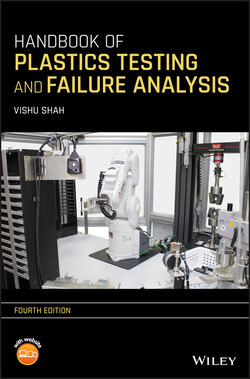Читать книгу Handbook of Plastics Testing and Failure Analysis - Vishu Shah - Страница 10
PREFACE TO THE THIRD EDITION
ОглавлениеDuring the period that elapsed between the second edition and the date of writing of this third edition, the author shifted his career from a full‐time molder to a full‐time Consultant/Expert witness/Educator. The opportunity existed for analyzing numerous plastic‐part‐related premature failures. Failure analysis and testing go together. In order to analyze the failure, it is often necessary to conduct tests. In this third edition, therefore, the decision was made to expand the current chapter on failure analysis substantially and alter the title of the book to Handbook of Testing and Failure Analysis to reflect the change appropriately.
Existing books and literature on the subject of failure analysis are too complex, too detailed, sometimes difficult to understand, and more suitable to the persons well‐versed in polymer chemistry and physics. This book attempts to simplify a rather difficult subject of failure analysis by focusing on four major types of failures and key reasons behind failure of plastic parts. A step‐by‐step procedure starting from very basic and simple visual analysis to highly advanced analytical tests is presented. A simple flow chart is included to help with the investigation. To assist with the understanding of the subject matter, several actual case studies are included. This simple approach to analyzing failures is not intended primarily for a specialist but for those who wish to acquire basic knowledge and understanding of the failure mechanism. The author’s aim is not to replace excellent books that are in existence on this subject but to supplement and pave the road for more detailed and sophisticated failure analysis techniques in existence today.
All other chapters in the book have been updated with the latest information, diagrams, and photographs of the test equipment. The Appendix section has been updated. Appendix I, which listed the properties of the most common plastics, elastomers, and rubbers in the early edition, has been replaced with information about four major electronic databases for plastic materials. In order to increase the versatility of the book, numerous color photographs depicting photoelastic analysis and color theory along with various animations have been added on to the compact disk that is included with the book. More importantly, a virtual tour of a prominent Plastics Testing Laboratory is included to give the reader an opportunity to visit the laboratory from his or her desk and learn and understand how the tests are conducted and data are collected.
The author wishes to express thanks to all the users of previous editions for their constructive comments and helpful suggestions for changes and improvements for the next edition and to those who helped with this revision. In particular, he wishes to thank Jim Beauregard and Jim Galipeau of Plastics Testing Laboratory for their invaluable contribution, agreeing to the novel concept of virtual laboratory tour and making it possible. The author also wishes to thank Gerard Nelson of Ceast USA, GE Plastics, Kishor Mehta of Plascon Associates, Bayer Corporation, Dr. Alex Redner of Strainoptics, Inc., Paul Gramann of The Madison Group, Jim Rancourt of Polymer Solutions, and Steve Ferry of Micobac Laboratories. Many thanks to Steve Tuszynski of Algoryx for his contribution and to all other companies for providing numerous illustrations and diagrams. The book by Myer Ezrin, Plastics Failure Guide, Causes and Prevention, has been an important and valuable source of theoretical and practical information, and the author highly recommends his book for more detailed and in‐depth discussion of the subject.
Once again, I would like to thank my family for their encouragement and constant support.
Vishu Shah
Consultek, LLC,Brea, CA
